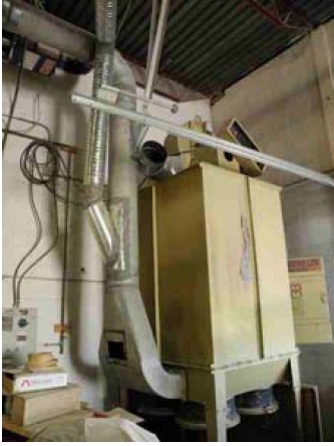Is your facility at risk for a fire or explosion? 5 ways to tell
From our Friends at: Canadian Biomass Magazine
June 29, 2017
By Erin Rayner / VETS Group
June 29, 2017 - In the last few years we’ve hosted introductory dust collection courses across Western Canada for dust producing facilities. Regardless of size of the facility or dust particulate produced there are a few key things to look for when evaluating whether or not your system is a fire or explosion waiting to happen.
 Dust collector in a millwork shop after a fire.
Dust collector in a millwork shop after a fire.1. To spiral or not to spiral? That is the question
On our travels we’ve seen and heard a lot about spiral pipe used in dust abatement systems. The question always comes up: is spiral duct a safe option for dust abatement systems? And the answer, if you’re dealing with a combustible dust such as wood dust, is NO, spiral duct is not an NFPA approved option. The next question is usually “Why?” A couple of reasons:
- The seam in spiral duct generates more friction and increases the risk for static discharge (source of ignition).
- Larger spiral duct cannot withstand explosion pressure or the weight of water being sprinkled if a fire were to occur.
- Refer to NFPA 91 Article: 4.3.5 for more information.
2. Plastic Rhymes with static
Some of the scariest, unsafe wood dust abatement systems we’ve seen have plastic or flexible hose somewhere along the system. It could be at the source of capture or used to navigate tight spaces in a retrofitted plant but the use of any plastic anywhere along the system is a big, red, flag that your wood dust abatement system is at risk of fire or explosion.
Fires and explosions needs a source of ignition to start. One source could be a static electric shock. In a static electrically charged environment, on a system with any plastic components, the chance of friction causing a static electric shock increases the risk of ignition. It’s not just plastic hoses. Any combination of friction and plastic or any non-conductive material can be a source of ignition. This is also why duct connection grounding is essential.
3. Cutting corners – we’re not talking about costs here…
Corners are sneaky places for dust to collect both outside and INSIDE a dust abatement system. Some case studies used in our dust collection 101 classes show systems that, from the outside look like they are performing, but when the square duct is taken apart, it’s revealed that even with what appears to be adequate airflow and pressure, material still collects in the corners of the system. This material creates fuel for an explosion. A compliant system has flanged, externally welded, round pipe with no corners or right angle dust catching spots and certainly no sharp 90 degree bends! In fact any corners in the facility if not regularly and efficiently cleaned, can collect dust that could become fuel for an explosion. An accumulation of 1/8 of an inch of dust over as little as 5 per cent of the surfaces is deemed hazardous. (NFPA 664 Article: 4.2.1)
4. No way out
One way to create a safe dust abatement system is to ensure, should there be an explosion, that any possible combustion has a clear and fast way out of the duct or building. It could be through approved explosion venting panels or a fire suppression system. NFPA standards are meant to address all possible risks to human life, equipment and facility. Even with all of the standards adhered to, a devastating, costly and possibly fatal mistake can still occur. Ensuring that your system has adequate explosion venting and suppression systems for the type of particulate in your facility will help provide a way to address an incident should it occur. Preventing a fire or explosion is better than dealing with one after the fact so including a spark detection system is highly recommended.
5. No fuel. No explosion
If five per cent of your facility is covered in 1/8 of an inch of dust, you’re creating the potential for a highly explosive environment (NFPA 664). Your dust collection system is updated, so no need for housekeeping now right? Wrong! Even with an updated dust collection system, frequent and efficient house keeping is crucial to maintaining a fire and explosion safe facility. Also, if you’re over the NFPA guideline of 1/8 of an inch of dust over 5 per cent of your facility you’ll have to invest in explosion proof electrical systems as well. Another good incentive to keep up the housekeeping. Remember: no fuel (dust) = no explosion.
Do you see anything familiar in these five points? If you’d like a Dust Collection 101 course for your staff or local association please let us know. We’re happy to share our experience and knowledge with you.
Erin Rayner is marketing and business development manager for VETS Group. www.vetsgroup.com @VETSsince1921
Comments
Post a Comment